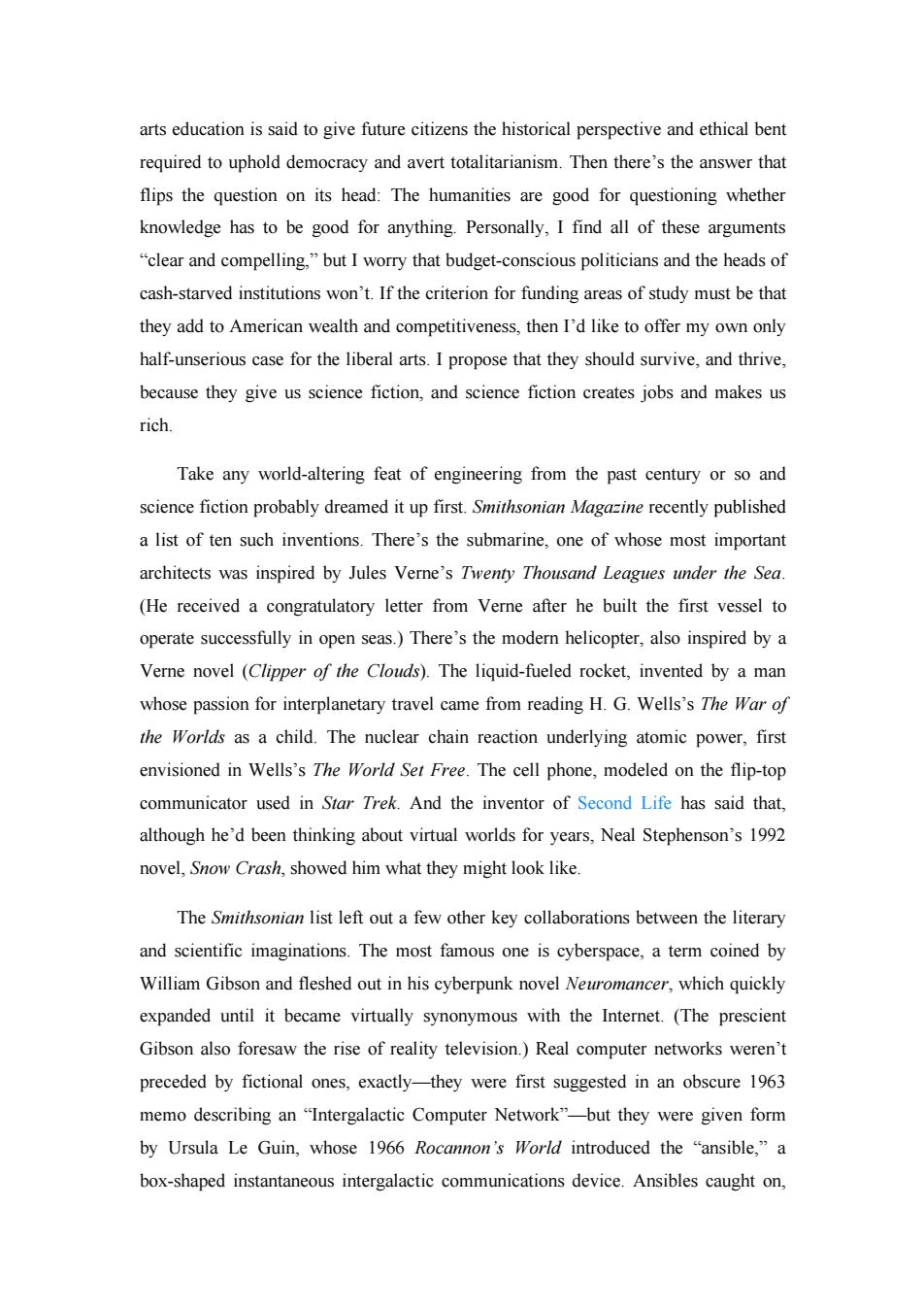正在加载图片...

arts education is said to give future citizens the historical perspective and ethical bent required to uphold democracy and avert totalitarianism.Then there's the answer that flips the question on its head:The humanities are good for questioning whether knowledge has to be good for anything.Personally,I find all of these arguments "clear and compelling,"but I worry that budget-conscious politicians and the heads of cash-starved institutions won't.If the criterion for funding areas of study must be that they add to American wealth and competitiveness,then I'd like to offer my own only half-unserious case for the liberal arts.I propose that they should survive,and thrive, because they give us science fiction,and science fiction creates jobs and makes us rich. Take any world-altering feat of engineering from the past century or so and science fiction probably dreamed it up first.Smithsonian Magazine recently published a list of ten such inventions.There's the submarine,one of whose most important architects was inspired by Jules Verne's Twenty Thousand Leagues under the Sea. (He received a congratulatory letter from Verne after he built the first vessel to operate successfully in open seas.)There's the modern helicopter,also inspired by a Verne novel (Clipper of the Clouds).The liquid-fueled rocket,invented by a man whose passion for interplanetary travel came from reading H.G.Wells's The War of the Worlds as a child.The nuclear chain reaction underlying atomic power,first envisioned in Wells's The World Set Free.The cell phone,modeled on the flip-top communicator used in Star Trek.And the inventor of Second Life has said that, although he'd been thinking about virtual worlds for years,Neal Stephenson's 1992 novel,Snow Crash,showed him what they might look like. The Smithsonian list left out a few other key collaborations between the literary and scientific imaginations.The most famous one is cyberspace,a term coined by William Gibson and fleshed out in his cyberpunk novel Neuromancer,which quickly expanded until it became virtually synonymous with the Internet.(The prescient Gibson also foresaw the rise of reality television.)Real computer networks weren't preceded by fictional ones,exactly-they were first suggested in an obscure 1963 memo describing an "Intergalactic Computer Network"-but they were given form by Ursula Le Guin,whose 1966 Rocannon's World introduced the "ansible,"a box-shaped instantaneous intergalactic communications device.Ansibles caught on,arts education is said to give future citizens the historical perspective and ethical bent required to uphold democracy and avert totalitarianism. Then there’s the answer that flips the question on its head: The humanities are good for questioning whether knowledge has to be good for anything. Personally, I find all of these arguments “clear and compelling,” but I worry that budget-conscious politicians and the heads of cash-starved institutions won’t. If the criterion for funding areas of study must be that they add to American wealth and competitiveness, then I’d like to offer my own only half-unserious case for the liberal arts. I propose that they should survive, and thrive, because they give us science fiction, and science fiction creates jobs and makes us rich. Take any world-altering feat of engineering from the past century or so and science fiction probably dreamed it up first. Smithsonian Magazine recently published a list of ten such inventions. There’s the submarine, one of whose most important architects was inspired by Jules Verne’s Twenty Thousand Leagues under the Sea. (He received a congratulatory letter from Verne after he built the first vessel to operate successfully in open seas.) There’s the modern helicopter, also inspired by a Verne novel (Clipper of the Clouds). The liquid-fueled rocket, invented by a man whose passion for interplanetary travel came from reading H. G. Wells’s The War of the Worlds as a child. The nuclear chain reaction underlying atomic power, first envisioned in Wells’s The World Set Free. The cell phone, modeled on the flip-top communicator used in Star Trek. And the inventor of Second Life has said that, although he’d been thinking about virtual worlds for years, Neal Stephenson’s 1992 novel, Snow Crash, showed him what they might look like. The Smithsonian list left out a few other key collaborations between the literary and scientific imaginations. The most famous one is cyberspace, a term coined by William Gibson and fleshed out in his cyberpunk novel Neuromancer, which quickly expanded until it became virtually synonymous with the Internet. (The prescient Gibson also foresaw the rise of reality television.) Real computer networks weren’t preceded by fictional ones, exactly—they were first suggested in an obscure 1963 memo describing an “Intergalactic Computer Network”—but they were given form by Ursula Le Guin, whose 1966 Rocannon’s World introduced the “ansible,” a box-shaped instantaneous intergalactic communications device. Ansibles caught on